
7 Steps on How to Write a Ranching Business Proposal
Securing funding or partnerships for your ranching business starts with a strong proposal. This guide will show you how to write a ranching business proposal, covering all key steps to make your proposal successful.
Key Takeaways
- Understanding your audience is essential for tailoring ranching proposals to meet their needs, enhancing relevance and persuasiveness.
- Structuring your proposal with clear sections, including a cover letter, table of contents, and client summary, improves readability and effectiveness.
- Using Proposal Kit templates and software can streamline the proposal-writing process while allowing for customization to better reflect your ranching business's unique offerings.
- Ranching proposals vary widely from startup business plan funding and selling products to responding to government RFPs, each with its own unique needs.
Understanding Your Audience

Understanding your audience is crucial for writing effective business proposals. Thorough audience research can significantly enhance your marketing strategy and customer engagement. Identifying your target audience enables you to customize your proposal to their specific needs and interests, making your pitch more persuasive and relevant.
Collecting customer demographics and understanding their history and interests can help build trust and rapport. Identifying what your potential clients value most allows you to create a proposal that speaks directly to them, increasing your chances of success. Additionally, choosing the right legal structure, such as forming a limited liability company (LLC), can protect both your business and personal assets from various liabilities.
Next, consider the different types of ranching proposals available.
Define Your Business
Determine the Nature of Your Ranching Operation
Defining the nature of your ranching operation is a foundational step in creating a comprehensive ranching business plan. Start by identifying the type of livestock you intend to produce. Are you focusing on cattle, sheep, goats, or perhaps a mix of livestock and crops? Clearly defining your production goals will help you outline the scale of your operation and the resources required.
Consider the size of your operation and set realistic production goals. Whether you aim to run a small, family-owned operation or a large-scale commercial ranch, understanding your capacity is crucial. Assess the resources you need, such as land, equipment, and labor. For instance, a cattle business will require specific types of grazing land and feeding equipment, while a crop-focused farm plus a small-scale animal farm might need irrigation systems and specialized machinery.
Identify potential risks and challenges associated with your operation. Factors like market fluctuations, weather conditions, and disease outbreaks can impact your business. Develop a risk management plan to mitigate these challenges, ensuring your business remains resilient and sustainable.
Identify Your Property Details and Resources
A thorough understanding of your property details and available resources is essential for effective business planning. Start by gathering information about the size and location of your property. The geographical location can influence factors such as climate, soil quality, water rights, and access to markets.
Evaluate the quality and type of soil on your property. Soil health is critical for both crop production and livestock grazing. Conduct soil tests to determine its composition and fertility and plan for any necessary soil amendments to optimize productivity.
Water availability is another crucial factor. Assess your water sources, such as wells, rivers, or rainwater collection systems, and develop a water management plan. Efficient water use is vital for both crop irrigation and livestock hydration.
Consider other resources like equipment and labor. Inventory your existing equipment and identify any additional tools or machinery needed for your operation. Similarly, evaluate your labor needs and plan for hiring or training staff to support your ranch business.
Develop a Clear Vision Statement for Your Ranch Business Plan
A clear vision statement is a cornerstone of a successful business plan. It defines your goals, values, and mission, guiding your decision-making process and aligning your team with a common purpose.
Start by outlining your short-term and long-term goals. Short-term goals might include increasing production efficiency or expanding your product line, while long-term goals could focus on sustainability and growth. Clearly defined goals provide direction and help measure progress.
Identify the values you want to uphold in your operation. These might include sustainability, animal welfare, and community engagement. Your values should reflect your commitment to ethical and responsible ranching practices.
Write a mission statement that encapsulates your business's purpose and aspirations. This statement should be concise and inspiring, guiding your decision-making process and communicating your vision to stakeholders.
Finally, establish metrics to measure the success of your business. These could include financial performance, production levels, food safety, customer satisfaction, and environmental impact. Regularly reviewing these metrics will help you stay on track and make informed decisions.
Conduct Market Research and Analysis
Understand Your Customer Base and Products for Sale

Understanding your customer base and the products you plan to sell is crucial for creating a comprehensive business plan. Start by identifying your target market. Who are your potential customers? Are they local consumers, restaurants, grocery stores, or perhaps larger distributors? Understanding their needs and preferences will help you tailor your products and marketing strategy.
Next, define the products you will offer. Whether you are selling organic produce, grass-fed beef, or artisanal dairy products, it's essential to differentiate your offerings from competitors. Highlight unique selling points such as sustainable ranching practices, superior quality, or local sourcing.
Assess the demand for your products. Conduct market research to understand current trends and consumer preferences. This might involve surveys, focus groups, or analyzing market reports. Understanding demand will help you plan production levels and marketing efforts effectively.
Identify potential risks and challenges in your market. These could include competition, changing consumer preferences, climate change, or economic fluctuations. Develop strategies to mitigate these risks, such as diversifying your product line or exploring new markets.
By thoroughly understanding your customer base and market dynamics, you can create a business plan that is both strategic and responsive to market needs. This approach will enhance your marketing strategy and increase the likelihood of success for your farming or ranching business.
Types of Ranching Project Proposals
Ranching proposals can vary widely depending on your goals and the nature of your project. Whether you're seeking educational grants, selling products to the military, or applying for a loan to expand your ranching capacity, each type of proposal requires a different approach. Recognizing the specific needs of your proposed project will help you create a more targeted and effective proposal.
For instance, a business plan might focus on the operational aspects and financial forecasts, while a ranching project proposal could emphasize sustainable practices and environmental impact. If you're in the cattle business, your proposal might highlight your strategies for improving livestock health and productivity. Each type of proposal has its unique requirements and focus areas.
Determining the type of proposal you need to write is the first step in creating a comprehensive and compelling document. With this foundation, you can proceed to structure your proposal effectively, ensuring all key components are covered.
Structuring Your Ranching Business Plan

A well-structured proposal helps organize your operations and serves as a roadmap for achieving your business goals. Good business planning requires significant time and effort to ensure thoroughness and effectiveness. Such a proposal not only clarifies your objectives but also makes it easier for potential investors to understand your project.
Business plans can take various formats, including written documents and sets of worksheets and spreadsheets. No matter the format, your proposal should include a cover letter, title page, table of contents, and client summary. These elements prepare the reader for the detailed sections that follow.
Next, focus on creating an engaging cover letter and title page.
Cover Letter and Title Page
A compelling cover letter sets a positive tone and engages the reader from the start. It should succinctly introduce your proposal by highlighting the key points and value proposition. Your cover letter is the first opportunity to make a strong impression, so ensure it is clear, concise, and compelling.
The title page should feature key details such as your business name, contact information, and the date. A tagline that encapsulates your value proposition can make your proposal more memorable. Together, these elements create a professional and inviting introduction to your proposal.
Table of Contents and Client Summary
Including a table of contents helps readers navigate the proposal efficiently, especially in lengthy documents. It allows them to locate specific sections quickly, improving the overall usability of your proposal. This is particularly important for comprehensive business plans covering various aspects of your ranching operations.
A client summary offers a brief overview and highlights the proposal's main points for quick understanding. This section allows potential clients to grasp the essence of your proposal at a glance, easing their decision on whether to delve deeper into the details.
Now that the structure is in place, focus on defining your customer's needs.
Defining the Customer's Needs

In this context a customer is the reader of the proposal, it may be a customer for a product or service sale, an agency giving grants, or a lender at a bank evaluating your business plan funding request.
A successful ranch proposal should address the recipient's specific interests and needs. A well-structured business plan serves as a roadmap for your ranching operation, clarifying objectives and assessing progress over time. Achieving this requires understanding and defining the customer's needs.
Effective business proposals often feature an executive summary outlining goals and solutions. This summary offers a snapshot of your entire proposal, making it easier for the reader to grasp your business goals and how you plan to achieve them.
Next, focus on identifying needs and wants.
Identifying Needs and Wants
Understanding the needs and wants of your potential customer is crucial for writing a winning proposal. Collect details about their history, past project approvals, and interests to tailor your proposal appropriately. This section should describe the needs and wants of your potential customer, along with any limitations, deadlines, or restrictions.
Demonstrating how your ranch's offerings meet market demands can effectively establish your value proposition over competitors. Aligning your proposal with the specific requirements of your target market can significantly increase its appeal.
Addressing Limitations, Deadlines, and Risk Management
Effective budget planning involves recognizing important factors, such as overhead expenses, and preparing for unexpected purchases. Forming a limited liability company (LLC) can also help manage financial risks by protecting personal assets from business liabilities. Budgeting helps track spending limits across different categories, ensuring the ranching plan stays on track and aligned with projected profits. Clearly outline project milestones and their respective deadlines to keep the project on schedule.
Identify expected challenges, such as location choice and weather conditions, which can affect resource costs and project viability. Preparing for unforeseen difficulties like natural disasters through mechanisms such as insurance is also crucial.
With these considerations in mind, focus on detailing your proposal.
Detailing Your Proposal

A detailed description of your proposal is crucial for clarity and persuasiveness. This section should provide a comprehensive overview of your plans, services, products, and any innovative ideas that set you apart from competitors. Proposal Kit can help streamline this process by offering pre-written templates and design options with customization software.
A good, comprehensive business plan outlines your project milestones, budget, and marketing strategy. Including these details makes your business plan more comprehensive, effectively conveying your vision and operational strategy.
Next, focus on the specifics of the project description.
Project Description
The project description should detail your plans, services, products, and any innovative ideas that set you apart from competitors. Clearly outlining the products your ranch aims to sell helps build a feasible business plan. Highlighting unique features like sustainable practices or eco-friendly methods can make your ranching project proposal more appealing to potential investors or partners.
Innovation in the proposal might involve new ranching techniques or technologies that enhance efficiency or sustainability. Justifying the need for a project often involves demonstrating the innovative aspects that set it apart from existing alternatives. Offering a comprehensive overview of the planned services or products is vital for establishing clarity in project goals.
It's essential to describe your plans, projects, services, products, and ideas in detail. This approach not only helps your proposal stand out but also ensures that all aspects of your operation are clearly communicated to potential stakeholders.
Unique Selling Points and Marketing Strategy
Highlighting unique selling points differentiates your proposal in a competitive ranching market. Incorporating sustainable grazing techniques benefits the environment and can lead to healthier livestock. Using advanced technology for livestock monitoring improves animal welfare and operational efficiency. Additionally, embracing organic practices can further enhance the sustainability of your operations.
Custom feeding programs tailored to the specific needs of different herds enhance the growth and health of the animals. Providing direct-to-consumer sales options ensures freshness and builds stronger relationships with clients.
Emphasizing these unique selling points significantly enhances the appeal of your proposal to potential clients.
Building Trust with Your Reader

Building trust with your reader is vital for the success of your proposal. Information about your company's history and experience in the ranching industry is essential for building trust. Sharing your company's background and expertise enhances your credibility and instills confidence in potential clients.
Testimonials build credibility and show that previous clients have had positive experiences with your services. Case studies offer concrete examples of past successes, demonstrating the effectiveness of your proposed plans to potential clients.
Company Background and Experience
Detailing your company's background and experience is crucial for establishing credibility. The USDA helps beginning farmers and ranchers by connecting them to local resources and offering one-on-one technical assistance and guidance. Training opportunities for beginning ranchers include field days, workshops, courses, and formal education programs related to ranching business.
A mission statement communicates what the company can do for its customers now. Highlighting unique features of the proposal enhances its attractiveness to potential investors or partners.
Pages like About Us, Company History, and Experience explain why the reader can trust that you will fulfill your promises.
Here are some related samples included in every downloadable Proposal Pack
The AI Writer generates a first draft of these templates - customized to your company, client, and project - in just minutes, giving you a head start on editing. Get any Proposal Pack or Proposal Kit Professional, and all of these samples, and the AI Writer are included.
Here are some related downloadable templates
The AI Writer generates a first draft of these templates - customized to your company, client, and project - in just minutes, giving you a head start on editing. Get any Proposal Pack or Proposal Kit Professional, and all of these templates and the AI Writer are included.
Testimonials and Case Studies
Customer success stories effectively demonstrate the impact of a farming or ranching business by showcasing real-world examples of how the business meets needs and generates value. Case studies in ranching often highlight specific challenges ranchers face and how innovative solutions helped them achieve success.
Testimonials from satisfied clients build credibility and trust as they endorse the ranching business's effectiveness. Case studies can be used across various platforms, including websites, social media, and email newsletters, to maximize their impact.
Proofreading and Polishing
Thorough proofreading enhances both the professionalism and clarity of a proposal. After compiling all information for your proposal, take the time to proofread each page and polish the wording and appearance to ensure it represents you at your professional best. Reading aloud can help identify awkward phrasing and improve the overall flow of the proposal.
Involving a colleague in proofreading can reveal overlooked mistakes and improve clarity. Utilizing online editing tools can assist in detecting errors but should be complemented with personal review. Formatting uniformity throughout a proposal contributes to a more polished and professional appearance.
Using Proposal Kit Templates

Using Proposal Kit templates and software can significantly streamline the proposal-writing process. These templates help ensure consistent organization and formatting, making it easier for the reader to navigate the proposal. It's important to customize Proposal Kit templates to align with the specific needs and goals of your ranching business.
Consider adjusting elements such as language, examples, and layout to better reflect your business's unique offerings and identity. Let's get into the specific benefits of using the Proposal Kit.
Benefits of Proposal Kit
The software provides guidance through templates, samples, and instructions, streamlining the proposal writing process. Proposal Kit aids in creating professional proposals by providing templates, instructions, and samples to guide users. This can be especially useful for creating ranching-related proposals. The Proposal Packs provide tailored pre-written templates, samples, graphic design options, and automation software for this purpose.
Additionally, the Proposal Kit includes thousands of professionally designed topic pages with instructions and examples, making it easier to write proposals. With extensive content such as legal contracts, a customizable line item quoting system, and customizable branding features, Proposal Kit Professional provides everything you need to create a polished, professional proposal.
Customizing Templates
Customizing Proposal Kit templates allows you to address the unique needs of your ranching business, making your proposal stand out. Elements that can be customized include project descriptions, services offered, and pricing structures tailored to your business model. Personalized templates enhance the clarity and professionalism of your proposals, increasing the likelihood of acceptance by potential clients.
By adjusting elements such as language, examples, and layout, you can better reflect your business's unique offerings and identity. This customization ensures that your proposal not only meets the specific needs of your project but also resonates more deeply with your audience.
Summary
Writing a comprehensive and compelling ranching business proposal involves understanding your audience, structuring your document effectively, and detailing your plans clearly. By focusing on your customer's needs and highlighting your unique selling points, you can create a persuasive and professional proposal that stands out in a competitive market.
Using tools like Proposal Kit can streamline this process, providing templates and guidance to help you create a polished proposal. Remember to proofread and polish your document to ensure it represents you at your professional best. With these steps, you'll be well on your way to securing the support and resources needed to bring your ranching vision to life.
 Proposal Kit Professional provides the most content, including legal contracts and a free design theme pack. Plus, advanced software features include custom branding and customizable quoting databases.
Proposal Kit Professional provides the most content, including legal contracts and a free design theme pack. Plus, advanced software features include custom branding and customizable quoting databases. Proposal Pack for Any Business covers this type of proposal and includes samples. There are also some commonly used specialty design themes available:
Proposal Pack for Any Business covers this type of proposal and includes samples. There are also some commonly used specialty design themes available:Photo Design Proposal Packs
Line Art Design Proposal Packs
Frequently Asked Questions
How can understanding my audience improve my ranching business proposal?
Understanding your audience allows you to tailor your proposal to their specific needs and interests, significantly increasing its persuasiveness and relevance. This focused approach can lead to better engagement and support for your ranching business.
What types of proposals can I create for my ranching business?
You can create proposals for educational grants, product sales, expansion loans, and livestock health improvements for your ranching business. Any type of ranching proposal for any situation or angle can be created using Proposal Kit. These options will help enhance your operations and financial sustainability.
What should I include in the project description section of my proposal?
Include comprehensive details about your plans, services, products, and any innovative ideas that set you apart from competitors in the project description section. This clarity will help convey the value of your proposal effectively.
How can the Proposal Kit help me write my ranching business proposal?
Proposal Kit can significantly streamline your ranching business proposal by providing thousands of professionally designed topic pages, pre-written templates, and samples. This comprehensive toolkit ensures you have the necessary resources and guidance to create a compelling proposal efficiently.
Why is it important to proofread and polish my proposal?
Proofreading and polishing your proposal is crucial because it enhances professionalism and clarity, ensuring you present yourself in the best possible light. A well-polished proposal makes a stronger impression on your audience.



 Cart
Cart
 Are you just looking for a template, sample, or software for your ranching proposals? Click these links to skip down the page and get right to it.
Are you just looking for a template, sample, or software for your ranching proposals? Click these links to skip down the page and get right to it.








 Facebook
Facebook YouTube
YouTube Bluesky
Bluesky Search Site
Search Site